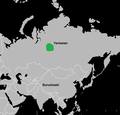case of deep prehistory). Next to internal linguistic evidence, the reconstruction of a prehistoric homeland makes use of a variety of disciplines, including... 44 KB (4,884 words) - 19:29, 21 March 2024 |
 | Proto-Afroasiatic homeland is the hypothetical place where speakers of the Proto-Afroasiatic language lived in a single linguistic community, or complex... 47 KB (5,689 words) - 03:56, 24 April 2024 |
Aryan race (section Debates on linguistic homeland) his Third Anniversary Discourse on the Hindus (1786). However, the linguistic homeland of the original speakers of Proto-Indo-European was a politicized... 65 KB (6,657 words) - 20:04, 25 April 2024 |
 | The Proto-Uralic homeland is the hypothetical place where speakers of the Proto-Uralic language lived in a single linguistic community, or complex of... 33 KB (4,339 words) - 02:30, 27 April 2024 |
Proto-Tupian language (section Linguistic homeland) Guarani, Awetï, Ayvu, etc. Rodrigues (2007) considers the Proto-Tupian linguistic homeland to be somewhere between the Guaporé and Aripuanã rivers, in the Madeira... 10 KB (601 words) - 00:38, 18 January 2024 |
Syriac language (redirect from Syriac linguistic identity) scholars as "Old Syrian/Syriac" or "Proto-Syrian/Syriac", although the linguistic homeland of the language in the region of Osroene, was never part of contemporary... 91 KB (8,568 words) - 05:01, 24 April 2024 |
 | "[in the language] of Neša") is an Indo-European language and thus linguistically distinct from the (non-Indo-European) Hattian language. The Hittites... 15 KB (1,777 words) - 18:23, 7 December 2023 |
between Western Neo-Aramaic and other Eastern Aramaic groups. Its linguistic homeland is located in northern parts of the historical region of Syria (modern... 14 KB (1,379 words) - 23:05, 23 February 2024 |
 | Ural-Altaic, Uralo-Altaic, Uraltaic, or Turanic is a linguistic convergence zone and abandoned language-family proposal uniting the Uralic and the Altaic... 31 KB (3,670 words) - 04:44, 18 April 2024 |
 | Albanian language (section Linguistic affinities) languages and people, rather than providing evidence of a possible linguistic homeland (also known as a Urheimat).[citation needed] The centre of Albanian... 177 KB (16,998 words) - 21:54, 13 April 2024 |
revision of the theory, however, Old Europe was a "secondary urheimat" (linguistic homeland) where the Greek, Armenian, and Balto-Slavic language families diverged... 25 KB (2,163 words) - 21:10, 23 April 2024 |
 | and linguist Roger Blench (1999). Václav Blažek (2019) places the linguistic homeland of Proto-Yeniseian close to where Burushaski is now spoken today... 6 KB (536 words) - 15:50, 10 December 2023 |
 | places the Pontic steppes of Ukraine and southern Russia as the linguistic homeland of the Proto-Indo-Europeans. The Yamnaya culture is identified with... 72 KB (7,178 words) - 04:12, 6 April 2024 |
displaced or intermingled with the original Jōmon inhabitants. The linguistic homeland of Proto-Koreans is located somewhere in Southern Siberia/Manchuria... 43 KB (4,870 words) - 03:01, 4 April 2024 |
 | Zamboanga is, according to anthropologist Alfred Kemp Pallasen the linguistic homeland of the Sama-Bajau people, and genetic studies also show that they... 5 KB (616 words) - 20:21, 17 February 2024 |
 | Manchuria during the Bronze Age. Most linguists similarly place the linguistic homeland of Proto-Korean and of early Koreans somewhere in Manchuria, such... 65 KB (6,805 words) - 04:35, 22 April 2024 |
 | Austronesian languages (redirect from Austronesian homeland) an idea of the original homeland of the populations ancestral to the Austronesian peoples (as opposed to strictly linguistic arguments), evidence from... 93 KB (7,236 words) - 13:48, 26 April 2024 |
 | Zamboanga is, according to anthropologist Alfred Kemp Pallasen the linguistic homeland of the Sama-Bajau people, and genetic studies also show that they... 19 KB (2,105 words) - 12:07, 1 April 2024 |
Linguistic distance is the measure of how different one language (or dialect) is from another. Although they lack a uniform approach to quantifying linguistic... 12 KB (1,316 words) - 04:39, 16 July 2023 |
divergent dialect of Eastern Japanese. It has been suggested that the linguistic homeland of Japonic may be located somewhere in southern, south-eastern, or... 42 KB (4,880 words) - 17:59, 21 April 2024 |
 | places the Pontic steppes of Ukraine and southern Russia as the linguistic homeland of the Proto-Indo-Europeans. The Yamnaya culture is identified with... 19 KB (1,674 words) - 16:13, 11 April 2024 |
 | Peninsula and the Japanese archipelago. It is suggested that the linguistic homeland of Japonic is located somewhere in south-eastern or eastern China... 43 KB (4,690 words) - 07:37, 11 April 2024 |
 | Sino-Tibetan languages (redirect from Sino-Tibetan homeland) James Richardson Logan, who added Karen in 1858. The third volume of the Linguistic Survey of India, edited by Sten Konow, was devoted to the Tibeto-Burman... 87 KB (8,552 words) - 05:53, 24 April 2024 |







